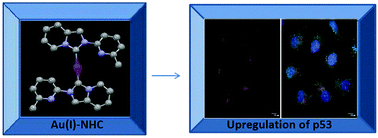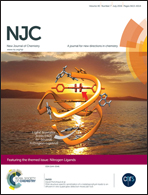Synthesis of gold(iii) ← gold(i)–NHC through disproportionation: the role of gold(i)–NHC in the induction of apoptosis in HepG2 cells†
Abstract
Starting from the proligand 2-[(6-methylpyridin-2-yl)]imidazo[1,5-a]pyridin-4-ylium hexafluorophosphate(1·PF6), three new complexes, viz. [Au(1)2] [PF6] (2), [1/2AuCl2, 1/2AuCl4]− [(1H)]+ (3), and [Au(1)Cl3] (4), have been synthesized and characterized employing different spectroscopic methods. [Au(1)Cl3] (4) has been synthesized by the disproportionation process. During the transformation of 2 to 4, the annelated proligand stabilizes both Au(I) and Au(III), and the isolation of the intermediate (3) confirms the conversion of Au(I) → Au(III) through the disproportionation pathway. The solid state structures of 2, 3 and 4 have been determined. Linear geometry was observed in 2, whereas complex 4 adopted square-planar geometry. Gold complexes 2 and 4 have been subjected to growth inhibitory studies. Complex 2 induced apoptosis in HepG2 cells along with increased expression of proteins involved in the mitochondrial death pathway, suggesting that apoptosis may occur via the mitochondrial death pathway.


 Please wait while we load your content...
Please wait while we load your content...